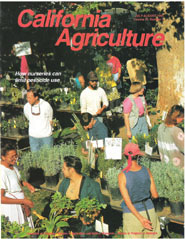All Issues

How nurseries can limit pesticide use
Cover:
Customers select purchases at a UC Davis Arboretum plant sale. Research showed that insecticide use in the nursery could be reduced without significantly affecting ornamental plant quality or sales. Photo by Jack Kelly Clark
July-August 1993
Volume 47, Number 4
Volume 47, Number 4





